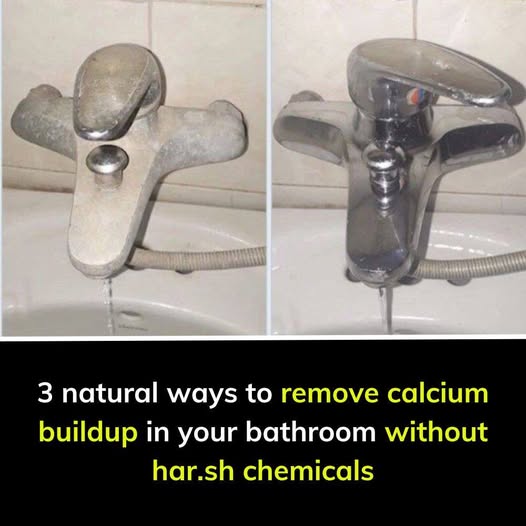ADVERTISEMENT
3 Natural Ways to Remove Calcium Buildup in Your Bathroom
Calcium buildup, often referred to as limescale, can accumulate in your bathroom over time, particularly in areas that are frequently exposed to water, such as faucets, showerheads, and tiles. While commercial cleaning products can be effective in removing these stubborn mineral deposits, they often contain harsh chemicals that can be detrimental to both your health and the environment. Thankfully, there are natural alternatives to remove calcium buildup that are safe, effective, and environmentally friendly.
In this article, we’ll explore three natural methods to tackle calcium buildup in your bathroom, helping you maintain a sparkling, fresh space without resorting to harmful chemicals.
What Causes Calcium Buildup?
Calcium buildup occurs when water containing high levels of minerals, also known as hard water, evaporates on surfaces in your bathroom. The minerals, including calcium and magnesium, are left behind, forming unsightly white streaks, spots, or scale. Over time, these deposits can accumulate and become harder to remove, leading to clogged showerheads, discolored tiles, and an overall grimy appearance.
While calcium buildup is inevitable in areas with hard water, regular cleaning can prevent it from becoming a major issue.
1. Vinegar: The Natural Calcium Remover
Vinegar is a household staple known for its cleaning properties. Its acidic nature makes it highly effective at dissolving mineral deposits, including calcium buildup. Using vinegar to remove limescale is not only safe for your bathroom surfaces but also a cost-effective solution.
How to Use Vinegar to Remove Calcium Buildup:
Materials Needed:
- White distilled vinegar
- Spray bottle
- Cleaning cloth or sponge
- Warm water
Instructions:
- Fill a Spray Bottle with Vinegar: Pour white distilled vinegar into a spray bottle. If you need extra cleaning power, you can heat the vinegar in the microwave for 30 seconds to a minute to make it more effective.
- Spray the Affected Areas: Spray the vinegar directly onto the areas with calcium buildup, such as faucets, showerheads, or tiles. Make sure the surface is thoroughly coated.
- Let it Sit: Allow the vinegar to sit for 15-20 minutes. The acidity will break down the mineral deposits, making them easier to remove.
- Scrub the Surface: After the waiting period, use a cloth or sponge to scrub the affected areas gently. You should see the calcium buildup beginning to dissolve.
- Rinse and Dry: Rinse the area with warm water to remove any leftover vinegar and mineral residue. Wipe the surface dry to prevent new buildup.
Why It Works:
The acetic acid in white vinegar reacts with the calcium deposits, breaking them down and making them easier to wipe away. The mild acidity is strong enough to dissolve the buildup but gentle enough not to damage most surfaces in your bathroom.
2. Baking Soda: A Gentle Abrasive Solution
Baking soda is another natural cleaning powerhouse that can be used to scrub away calcium buildup. As a gentle abrasive, it helps to remove mineral deposits without scratching your bathroom surfaces. When combined with vinegar or water, baking soda works effectively to break down stubborn buildup.
How to Use Baking Soda to Remove Calcium Buildup:
Materials Needed:
- Baking soda
- White vinegar or water
- Small bowl
- Cleaning cloth or sponge
Instructions:
- Make a Baking Soda Paste: In a small bowl, mix baking soda with enough white vinegar or water to form a thick paste. If you’re using vinegar, the paste will fizz slightly, which is a good sign that it’s working.
- Apply the Paste to the Affected Areas: Using a cleaning cloth or sponge, apply the paste to areas with calcium buildup. You can use this method on faucets, tiles, and showerheads.
- Let the Paste Sit: Allow the paste to sit for about 15 minutes. The abrasive texture will help loosen the mineral deposits, while the vinegar or water works to dissolve them.
- Scrub the Surface: Gently scrub the areas with a cloth or sponge. For more stubborn deposits, you can use a soft brush (like an old toothbrush) to get into hard-to-reach spots.
- Rinse and Dry: Rinse the area with warm water and wipe it dry. This will help prevent any new buildup from forming.
Why It Works:
Baking soda’s abrasive texture helps dislodge the calcium deposits without damaging the surface beneath. When combined with vinegar or water, it enhances the cleaning power and makes the task easier.
3. Lemon Juice: A Natural and Refreshing Solution
Lemon juice, like vinegar, is acidic and can break down calcium deposits with ease. Additionally, its fresh scent makes it a great alternative to harsh chemical cleaners. Lemon juice is especially useful for removing calcium buildup on faucets, showerheads, and glass surfaces, leaving them looking clean and shiny.
How to Use Lemon Juice to Remove Calcium Buildup:
Materials Needed:
- Fresh lemons or bottled lemon juice
- Clean cloth or sponge
- Warm water
For Complete Cooking STEPS Please Head On Over To Next Page Or Open button (>) and don’t forget to SHARE with your Facebook friends
ADVERTISEMENT
